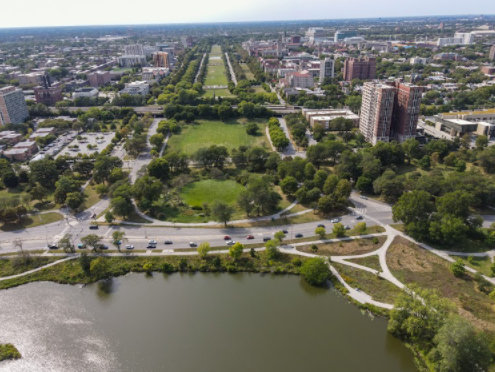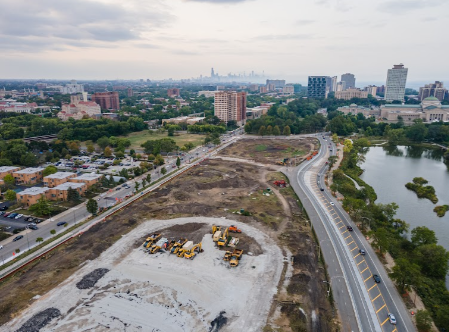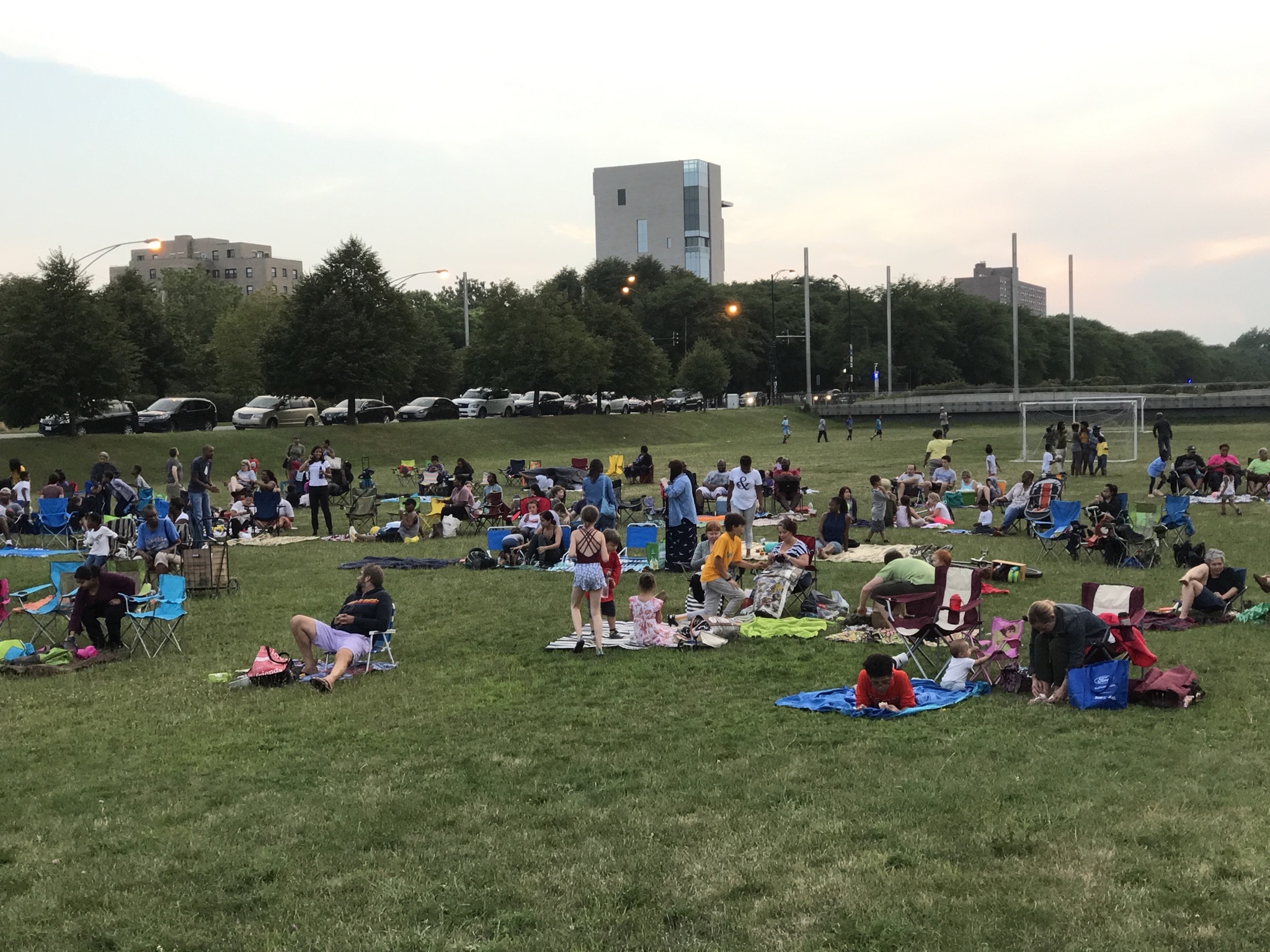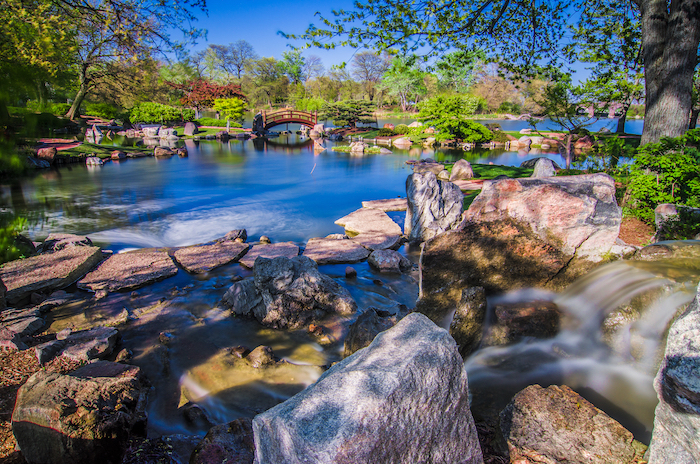
On Tuesday, September 28, 2021, former President Barack Obama and former First Lady Michelle Obama visited historic Jackson Park (Project No. 01902) in Chicago, IL for the Obama Presidential Center’s (OPC) ceremonial groundbreaking.
This groundbreaking took place weeks after construction crews began demolishing the site— a plot of parkland along the South Side’s sublime Lake Michigan waterfront. Aside from a few social media posts, including a Twitter thread by @EricAllixRogers, the drastic changes to the park went largely unnoticed and garnered little media coverage despite the park’s seemingly overnight alteration.

First announced six years ago, the proposed OPC has been the subject of regulatory reviews, public outcry, and legal challenges, which are still ongoing. On September 20 and September 27, plaintiff Protect our Parks and amici curiae— including the National Association for Olmsted Parks (NAOP)— submitted briefs urging the court to enjoin further action by the Obama Foundation because of the failure to abide by legal and regulatory requirements.
NAOP was one of the first organizations to publicly object to the “appropriation of public parkland for … privatized use” in a letter to First Lady Michelle Obama in 2015.
For $10, the City of Chicago has entered into a 99-year lease with the private Obama Foundation, giving 20 acres of public parkland to the Foundation for a complex of buildings, including a 23-story tower that will dominate the lakefront, a new parking garage that will hold 400 cars and a new active recreation area in the Midway Plaisance. The project will remove 24 acres of well-designed roads, including Marquette and Cornell Drives, and it will result in the destruction of nearly a thousand heritage trees in the migratory pathway.
NAOP’s stance is— and has always been— that it is important to house a vibrant presidential center in Chicago to honor the 44th President. However, there is no reason to sacrifice Jackson Park. As outlined by NAOP and others, the Foundation has set a disturbing precedent by appropriating public parkland for a private purpose in the face of decades of dedicated protection of the Park by city leaders.
NAOP and others have argued that the flawed review process paid little attention to alternative sites— as mandated by law and regulation— even though an alternative location could save the park and allow the OPC to proceed. Other concerns have been the project’s potential to displace existing neighborhoods and prompt gentrification, its damaging environmental impact, and the loss of open vistas to the lakefront— one of Olmsted’s goals in designing Jackson Park. The Obama Foundation and others have argued that the project is an investment in the neighborhood, which the Obamas once called home.
NAOP served as a Section 106 consulting party in the Jackson Park review proceeding and submitted various letters and opinions: a 2015 letter to the First Lady, a 2018 letter to the City of Chicago’s Department of Planning and Development, a 2020 letter to the Federal Highway Administration, and a 2020 press release.
Jackson Park was designed by Frederick Law Olmsted and Calvert Vaux— the iconic duo who designed Central Park in NYC— in 1871 as part of a comprehensive park system known as South Park. While many plans for South Park were abandoned after the devastating Chicago Fire city fathers later invited Olmsted to return to Chicago to locate the 1893 World’s Columbian Exposition and serve as landscape architect for the fair.
Jackson Park was placed on the National Register in 1972. It is one of Chicago’s largest and most historically significant parks, embodying key Olmstedian values.
In its amicus brief, NAOP called for the court to enjoin further action by the Obama Foundation:
If the Foundation is allowed to commandeer this space for a privately owned and operated facility, it will effectively reverse centuries of American practice— that public parks belong to the public. The message will be that public lands are up for grabs by powerful political interests.…..
Access to safe, quality open space has never been more important. Yet, in city after city — Chicago, Brooklyn, and Boston, to name a few— our parks and green spaces are being threatened by structures for private purposes. As Olmsted knew, the value of a park is the absence of structure …. Once gone, open space is lost forever.
If allowed to proceed, NAOP argues, Chicago and the public will be deprived of a key democratic space; resilient green infrastructure that Olmsted intended for the lakeshore; and accessible and workable circulation. The potential consequences— both historical and ecological— are tragic. Jackson Park offers a sad but valuable lesson that we can never take our historic Olmsted parks and landscapes for granted.
Without communities of dedicated advocates who understand the importance of parks— and the significance of Olmsted’s legacy— these spaces risk being lost to development or indifference.
NAOP is working to grow existing audiences and identify new audiences, introducing them to Olmsted’s legacy and empowering them to be advocates for the protection of these historic and natural treasures.
Anne Neal Petri is the President and CEO of the National Association for Olmsted Parks. The views expressed in this article are those of NAOP.
This article first appeared in the October 1, 2021, issue of Field Notes by NAOP. As we went to press, we learned that NAOP’s motion for leave to file an amicus brief was denied without explanation.










